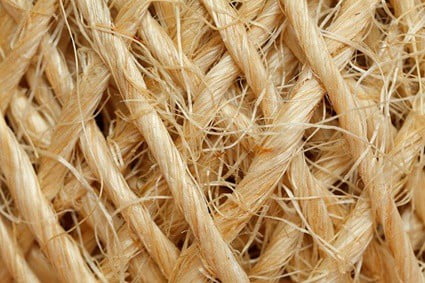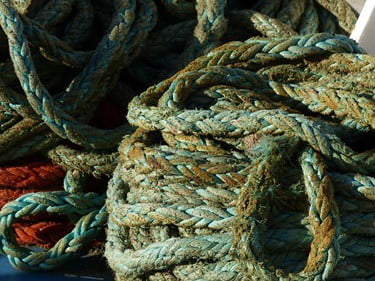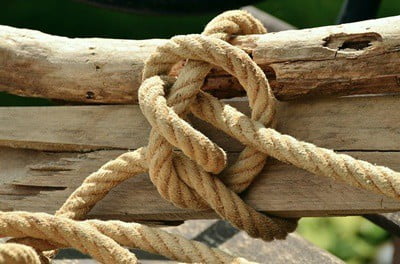Owners know that rabbits should be given toys to play with to keep them occupied and prevent boredom. You may have seen kinds of rabbit toys with rope. Likewise, you may have considered giving your rabbit some basic rope to play with. However, you need to ensure that it’s pet safe.
The safest rope for rabbits is made with natural plant fibers. This will help avoid poisoning your rabbit with plastics. The rope cannot be a blended material, as synthetic components are impossible to digest. The rope must be untreated or your rabbit may ingest toxins.
Instead, give your rabbit a pet-safe rope to chew on. Otherwise, your rabbit is at serious risk of intestinal blockages or toxic shock. If you’re on a budget and would like alternatives to fancy ropes, what are your options? You can narrow down the most and least harmful ropes for rabbits.
Is Jute Twine Safe for Rabbits?
Jute is known for its sheen, as well as its affordability. It’s only second to cotton in terms of production and versatility. Jute rope is named after the plant it is made from. The jute plant is also used to make burlap cloth, a highly durable material.
Because it is made from a plant, jute rope is safe for rabbits. As a matter of fact, jute is the most common material used for making natural rabbit toys. It’s durable, easy to attain, and unlikely to cause your rabbit any harm, as it doesn’t require synthetics to remain strong.
Is Sisal Rope Safe for Rabbits?
Sisal rope is made from a species of agave. It is sometimes also called sisal hemp, although it is not technically hemp. Rather, hemp is used as a catch-all phrase for plants that are made into fiber.
As such, sisal is primarily made for twine and rope, but it also has other uses. This versatile plant can be made into cloth, hats, bags, paper, and even dartboards. It is so strong that it is used to reinforce fiberglass, rubber, and cement products.
When it is used for rope, this strength comes in handy. Like jute, it is a plant-based rope, making sisal OK for rabbits to munch on. Sisal rope is very easy to find, so you won’t break the bank on expensive pet toys.
If you know people who use a smoker, chances are, they have sisal rope with them. However, they probably know it as baling twine. Baling twine is sometimes treated and made with synthetic fibers. However, if anyone uses it for food, it’s likely made of untreated sisal fibers to prevent digestive issues. In this way, it will be safe for your rabbit.
You will also find baling twine in farms, but this kind is not safe for your rabbit. Farmers use a twine treated to be anti-rodent. This stops mice and rats from chewing on these necessary bindings. While this is great for farmers, it’s not so great for your rabbit. It can fall prey to the repellant just as easy as mice or rats.
Is Hemp Rope Safe for Rabbits?
Hemp has a long history as a rope fiber. It was first spun as a fiber about 50,000 years ago. It can be traced as far back as the Age of Sail, serving as both rope and the sails themselves. In fact, the word canvas comes from the name of the cannabis plant.
Other than fiber, hemp is also a material used in many different ways. These include clothes, biofuel, and even biodegradable plastics. Of course, with its accessibility and durability, you can also find it as a rabbit toy.
If you’ve ever seen rabbit toys made with hemp, you may have wondered about its THC content. This plant contains tetrahydrocannabinol, better known as THC, which is a psychoactive compound.
Hemp is a great material for rabbit toys. It is versatile, strong, and very safe for your rabbit. It won’t bite through the rope easily, it won’t experience any digestive issues, and it won’t get high either.

Other Safe Materials
Aside from these three common materials, there are other kinds that are made into rope. As you browse around for more unique rabbit toys, you may wonder if these options are safe.
Seagrass
When shopping for rope, you may encounter a material called seagrass. Seagrass, as you may expect, is the grass-like plants that you see in the ocean. Technically speaking, it’s not grass. Instead, it’s a type of flowering plant. The ‘grass’ that you see flourishing on the seabed are its leaves.
Like other natural plant fibers, seagrass makes a safe rope for your rabbit. In fact, you can typically find these in pet stores for other animals. Due to its length and durability, seagrass is woven into tunnels and mats.
Manila
Manila rope is another natural plant fiber that is made into a strong rope. You’ll find its origins in the abaca plant, a type of banana. This plant fiber is also called manila hemp, but this is only in name. It doesn’t have any relation to hemp plants, and therefore does not contain any amount of THC.
One of manila rope’s interesting characteristics is how it reacts to moisture. When wet, it becomes smaller, shrinking in size. This characteristic makes manila rope more rabbit-friendly, as bunnies are incredibly prone to intestinal blockages. Unlike other kinds of rope, which remain the same size or expand, any fibers your bunny chews off manila will get smaller inside of it. In the gut, smaller fibers mean less chance of blockages.
Coir
Coir rope is made from coconut fibers. Specifically, it is extracted from the outer husk of the coconut. These fibers create a strong, dense rope that has been used throughout history. In fact, coir has been a favorite material for cording as far back as the 11th century AD.
Even more impressively, according to an article in the Annual Australian Earthquake Engineering Society Conference, coir is strong enough to be used in reinforced concrete beams.
Because it is made from coconut fibers, coir rope is safe for your rabbit. Just make sure to find untreated coir rope. Without synthetic components, this option will be safe for gnawing, and even survive for quite a while.
Unsafe Materials
With all these good examples, you may assume all rope is safe for rabbits. So long as it’s not synthetic or treated with chemicals, what’s the harm?
There are several kinds that are actively dangerous for rabbits. While shopping for bunny toys, if you encounter these ingredients, keep scrolling:
Paper Rope
A less common material used as a rope is paper. Specifically, paper rope is made by twisting craft paper with glue to make it into a rope. The end product makes a string that resembles the look and feel of rattan. For this reason, this material is also sometimes called paper wicker.
Untreated wicker is a material safe for rabbits. Paper rope, or paper wicker, on the other hand, is not safe for rabbits. Paper itself isn’t harmful to rabbits in small amounts. However, the danger of paper rope lies in the chemical treatment that the fibers are subjected to.
This treatment allows the fibers to hold their shape, but can be poisonous to your rabbit. Likewise, fibers’ tenacity in holding their shape can dramatically increase the chances of an intestinal block.
Cotton
Cotton rope may seem like a good toy to share with your rabbit. After all, what’s more natural than cotton? This material does make a gentle, supple rope with strong fibers. With this softness, you may think that it is OK for rabbits.
Unfortunately, any rope made with cotton will be dangerous for rabbits. Even if cotton is only a small part of the rope’s material, it will still be harmful to your pet bun. This is because most cotton fabrics are made from synthetic fibers. Since these are man-made, these fibers will likely be toxic to your rabbit when ingested.
On the other hand, natural cotton isn’t any better. Like all fabrics, cotton has a high chance of causing blockages in your rabbit’s stomach. The fibers are likely to bunch up, twist together, and compact upon being exposed to liquid. Inside a bunny’s stomach, that’s dangerous.
So, softness may be good for the skin. However, inside pliable intestines, the firmer the rope, the better, as it’s unlikely to bind up with other things.
Polypropylene And Synthetic Materials
If you have a piece of rope lying nearby, chances are, it’s probably made of polypropylene. Polypropylene is one of the most common materials used for rope. It’s easy to produce in mass and very cheap. Unfortunately, this material is synthetic, so it is unsafe for your rabbit.
Synthetic materials cannot be digested. This makes intestinal blockages more likely if your rabbit eats this material. It will not break down in its gut, even if your rabbit only eats a small bit of it. To make things worse, it’s often made using compounds that are toxic to your rabbit.
Other than polypropylene, there are other synthetic compounds to watch out for. These include polyester, nylon, and acrylic. All of these will be difficult or impossible for your bunny to digest. As a result, the odds of intestinal blockages are increased.
Treated Rope
Aside from the rope’s material, you should also check if a rope has been treated. This is because any treatments used will almost always be synthetic. At the very least, it will not be plant-based. Synthetic and animal-based materials cannot be digested by rabbits.
For example, a common treatment of sisal rope is with rodent repellent.
There is a chemical called copper naphthenate. This is used to preserve wood, and of course, rope. Copper naphthenate makes rope mildew resistant. This eventually helps in stopping the rope from breaking down and fraying. As such, it’s highly valuable for ropes made with natural fibers.
Treatments can also increase the strength of fibers. For example, an article from Bioresource Technology determined that jute rope can be strengthened with an alkali solution. In fact, it can boost the rope’s durability by as much as 65%.
Treated rope is often an improvement over its untreated counterparts. However, it makes rope toxic to your rabbit.
Blended Fibers
Sometimes, rope is made of blended materials. This is because mixing components often creates a rope superior to those made with just one type. A common pairing is cotton-hemp ropes and cotton-jute ropes. To do this, you need to introduce certain chemicals. These chemicals allow different materials to bind to each other.
However, these chemicals are often synthetic. Therefore, the extra material and the chemicals used to bind it will not be safe for your rabbit. When shopping for rope for your pet bun, it’s best to stick to kinds that use just one material.
How To Pick a Rope for Rabbits
Here’s a checklist for selecting a rabbit-safe rope:
Made of Natural Materials
Rabbits should only ever be given rope that is made of natural, plant-based fibers. This includes the common rope materials, such as hemp, jute, and sisal. With natural fibers, you are sure that there is nothing mixed in that is toxic to your rabbit.
Additionally, natural fibers will be easier to digest. Your rabbit shouldn’t be eating its toys wholesale. However, when gnawing on a new rope, your rabbit is bound to ingest a little. If it does, natural fibers will have a smaller chance of causing an intestinal blockage.
Not Blended
Once you’ve ensured the rope is made of natural fibers, be sure it’s made only of that material – and nothing more.
Ropes are often made with a combination of fibers. A common example is cotton and hemp, as well as a cotton and jute blend. As you may recall, cotton isn’t a particularly rabbit-friendly product. Even natural cotton fibers are dangerous. As such, despite the rope’s cheaper price, it’s not worth the risk for your bunny.
This blending is done so that the rope becomes stronger and more durable. However, your rabbit doesn’t need any of that strength and durability. Instead, your rabbit needs rope that will not wreck its gut after a munching session.
To ensure that it is completely safe, look for ropes that are made of 100% natural fibers. This will ensure that your rabbit remains completely safe during playtime.
Not Treated or Coated
Look for the words ‘untreated’ on the package. This is to ensure that your rabbit isn’t ingesting any toxic chemicals. If you have trouble finding untreated rope, look for a rope that is meant for culinary purposes.
How do you know if a rope is treated? If the package is unspecific, or if you’re checking at a glance, keep this in mind: Treated rope is often colored green or orange. It will also have a waxy or oily smell.
However, if you’re still unsure, it’s best to avoid the rope. After all, when it comes to your rabbit’s health, it’s wise to stay on the safe side.
Why Rope Isn’t Safe for Rabbits
With all that said, rope isn’t an ideal toy for your rabbit. This is because rabbits have powerful teeth and are prone to breaking apart their toys. This makes it easy for them to ingest the pieces. You’ll note there are few plastic toys for your rabbit available on the market.
While there are safer ropes for your bunny, all ropes pose some risk. If you cannot supervise your rabbit, it’s wise not to give it a rope toy. Otherwise, that can lead to these health risks:

Rope Causes Intestinal Blockage When Eaten
A bunny’s digestive system is not designed to ingest anything inedible. Even if it’s made of natural materials, there is still a chance that your rabbit’s rope toy will cause gut issues.
Most of the time, the chances of this happening are minimal. Plant-based fibers are easier on the digestive system. Blockages only ever happen if your rabbit eats an excessive amount of the rope.
Nonetheless, this means that you should keep an eye out on your rabbit’s toys. The taste may be appealing to your rabbit, causing it to like the rope too much. If you notice that your rabbit is chewing on its rope, it’s best to switch to materials that it doesn’t chew on. In this way, you can minimize the risk of digestive issues.
Rabbits Get Stuck
Ropes are inherently risky toys. This is because ropes are used for tying and binding. For soft ropes, like cotton, or lengthy toys, like balls of twine, this risk is increased. Your rabbit may get stuck in its own rope toy. This is especially true in small spaces, where your rabbit’s limbs can get tangled.
Rabbits can very easily break their bones. This is because the bones are light and delicate. This makes bunnies quick and agile creatures, but it also makes them prone to fractures and cracks.
However, this doesn’t mean that all kinds of rope are immediately unsafe for rabbits. Commercial rope toys are often tightly coiled to prevent fraying. This lessens the chance of your rabbit eating through the rope and pulling at the fibers. It also makes it difficult for the rabbit to bend and loop the rope by accident, entangling itself.
As such, check that the rope has a tight weave. This will lessen the chances of your rabbit’s limbs getting stuck or breaking its bones.
Rabbits deserve enrichment from toys like tunnels, mats, and of course, rope toys. However, when buying and making toys, you should always put your rabbit’s safety first. Be sure the rope is tightly woven, made of non-toxic materials, is unblended, and is composed of natural fibers.
After that, be sure to supervise your bunny with the rope to keep it from ingesting or becoming entangled in the rope. This will help keep your rabbit safe and entertained.


I appreciate your detailed explanations re: firmer rope being preferable to soft rope and how materials break down and twist in the intestinal environment, increasing risk of blockages. This is probably the definitive guide on the web on this topic—now I don’t have to trawl through old forum posts!
Manila would be safe if it could be ordered without being oiled. If anyone knows a source of untreated manila, please share. Without the oil (like diesel), the rope can’t get wet. There’s not much use for rope that can’t be outside. Natural manila is just undyed, but still oiled.